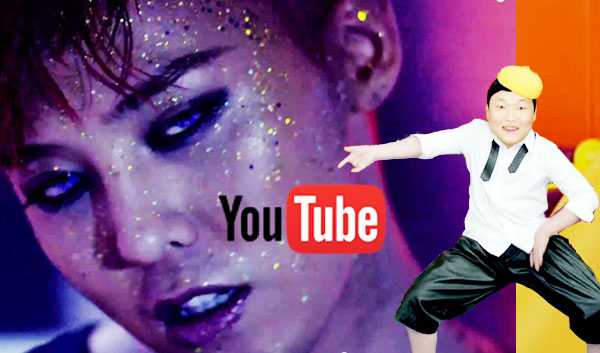
With the rise of social media in the last decade, K-pop has made its way to the international realm. Oh and Park’s article argues that social media outlets such as YouTube are pivotal to K-pop’s global expansion; however, artists and music producers have to “find other sources of revenues streams” since music consumers, specifically K-pop fans, are not required to pay to access music content from their favourite soloists or groups on YouTube (Oh and Park 2012: 368-372). As long as the digital gadget is accessible to the Internet, fans can stream their favourite music videos via the YouTube app. Therefore, social media platforms may serve as a mode of promotion for the musical content of the artists, but it is not enough to financially sustain soloists or groups in South Korea.
In relation, Oh and Park point out that the decreasing sales CDs and DVDs is due to the “rampant unchecked piracy”. K-pop fans do not need to buy the entire album because virtual music shops like iTunes make it possible for consumers to purchase the songs they only like, which help producers combat piracy (Oh and Park 2012: 372-374). Despite profit from digital singles or albums, it does not necessarily make  an artist financially stable. According to a news report by JTBC Newsroom from August 21st, 2017, an artist makes 0.42 won, which is about $0.00042 per streaming. In a given example, Heize had only earned 2.7 million won, about $2,700, in spite of topping every chart ranking in July 2017. The news provides a breakdown of the profit: 40% for the distribution; 44% for the production; 10% for composition/writing/editing; and the remaining 6% goes to the artist. This reveals that the artist themselves earn the least in streaming, which has led to some artists to participate in song writing.
an artist financially stable. According to a news report by JTBC Newsroom from August 21st, 2017, an artist makes 0.42 won, which is about $0.00042 per streaming. In a given example, Heize had only earned 2.7 million won, about $2,700, in spite of topping every chart ranking in July 2017. The news provides a breakdown of the profit: 40% for the distribution; 44% for the production; 10% for composition/writing/editing; and the remaining 6% goes to the artist. This reveals that the artist themselves earn the least in streaming, which has led to some artists to participate in song writing.

On a brighter note, Oh and Park note that K-pop artists and their entertainment companies gain more profit from sponsorships, advertisements, appearance fees, and overseas royalties. Although the traditional B2C (Business to Consumer) model had been impacted by the digital age, entertainment companies have managed to look for alternatives to guarantee revenue maximization through the B2B (Business to Business) model (Oh and Park 2012: 383).
In conclusion, the digital age has slightly affected the CD market, but it has also driven artists and music producers to be creative music-wise and business-wise in order to stand out from the oversaturated music industry. More importantly, it has lessened the distance between artists and their fans.
O, Daeyeong. “(Paekteuchekeu) Gasu 0.42 won…’eumwon suik baebun’ jeokjanghanga? [(Fact check) Singer 0.42 won…’Music revenue distribution’ appropriate?].” JTBC News, Aug. 21, 2017. http://news.jtbc.joins.com/article/article.aspx?news_id=NB11510500.
Oh, Ingyu, and Gil-Sung Park. “From B2C to B2B: Selling Korean Pop Music in the Age of New Social Media.” Korea Observer, Vol.43, No.3 (2012): 365-397.
I like it! I might include a page number on the first Oh and Park reference, since you have a quote, but overall you’ve taken a hard look at the finances and seen how the current financial model is NOT positive for the performers themselves.
Thank you for the feedback, Dr. Saeji. I’m glad you liked it.
I strongly agree with your argument that artists should find another “source of revenues streams”. Accompanying with various social media companies and organizations involving in the entertainment industry, the original B2C (Business to Consumer) model transfers to B2B (Business to Business) model. The benefit which entertainment companies and artists can gain from music selling become less and less. Sometimes, the money which gained from selling albums cannot even cover the cost for making records. One strategy which can help to maintain the sales volume of albums is to focus on innovation. Entertainment companies can use different ways to make the albums attractive such as creating a more impressed visual effect for cover and photo books and putting some special bonus in the albums. For instance, as the top-selling K-pop idol, BTS used several ways to presell their consumers. They put a different bonus in the albums such as cards, pamphlets and stickers, and they also release several versions of photo books with the album. As consumer can only get one random card and one random version photo book with one album, the consumer has to buy a various album in order to get their favorite card and favorite version photo book. As the pamphlets in every album are relates to each other, the consumer has to buy the whole collection of the albums in order to read the entire story. By using these creative strategies, artists and companies can still be financially sustainable in selling albums.
Furthermore, I think technology and social media can also be an impetus for artists to gain profits. More and more K-pop group these days show their fans about the details of their personal life through social media. These posts about idols’ daily life make idols’ personas more enhanced and more realistic and therefore pushes fans to buy some related media products such as pay-per-view reality show and DVDs. The sales of concert tickets and other related products such as official light sticks, posters, official T-shirts and premium photos will also increase along with fans’ growing sense of love. In that way, artists can earn a comfortable income by selling these products.
I want to point out that while $0.00042 per stream (approximately 6% of $0.007 total revenue per stream) sounds like very little, Heize still earned $2,700 weekly. This means that even if a track isn’t a chart topper, the artist still earns a respectable amount. That is just from streaming alone, without physical sales, sponsorships, advertisements, appearances, and other types of promotions. Not only that, streaming services help fight piracy since they provide an easy, legal way to consume content without the public having to illegally download.
Also, as you mentioned, the digital era brings platforms like YouTube, which makes it much easier for fans to access content. This leads to a massive increase in the number of people who are able to access the artists’ content. This has several benefits for the artist. First, ads and product placements are able to reach a much bigger audience. Second, it increases exposure, so new fans who may not have heard of the artist before are able to discover them much more easily.
Lastly, I want to discuss social media platforms. Many artists interact with their fans using social media like Instagram and Twitter. This brings many benefits to the artists as well. First, fans themselves like to promote their artists through social media. For example, BTS fans on Twitter encourage each other to attend concerts, buy albums, vote for BTS in awards regularly. Second, artists can use social media to make extra money. I’ve seen many popular artists promote products through Instagram, for which I’m assuming they are being compensated well.
My conclusion is that the digital era is a really good time for artists financially. Of course, this depends entirely on how well artists and their agencies take advantage of the new platforms available to them. As long as streaming services, YouTube, and social media are being managed properly, it can only do good for the artist. The only artists at a disadvantage in the digital era are those who were not able to keep up with the technology, and those who did not take advantage of the new digital platforms properly.
I agree with your statement that K-pop stars get a lot of attention/recognition through YouTube, however, the opportunity cost to these benefits is that they don’t gain any financial income every time a viewer streams their music or video. In addition, viewers could also go to websites like “2conv” or “ytmp3” to convert any YouTube videos of their choice into a mp3 player to listen on their phone, laptop or TV without having to pay a single penny.
Moving on to your next statement about how and why K-pop idols are not able to sell more CDs and DVDs than they can supply. iTunes plays a big role in the decrease of sales for CDs and DVDs for all artist (not just K-pop) because they can buy certain songs instead of the whole album, which may only have a few songs that the consumers would listen to. iTunes now has “Apple Music”, which allows consumers to download as much music as they want, but they would have to commit to a monthly subscription. Another reason to why CDs and DVDs aren’t being sold as much is because of modern day technology. For example, Apple’s new laptop doesn’t have a CD port because most programs, music, and videos are available online to download to your computer. Therefore, it’s not necessary to buy a music CD or a DVD because you can just buy the music online without having to physically move.
From looking at the statistics of how much a K-pop artist makes by JTBC Newsroom, it’s both shocking and sad to see that artist getting only 6% of the profit from streaming. Referring to your comment about how some artists are going to participate in song writing to make more money. This adds a lot of pressure to the artist because not only do they have to sing and dance, they’re also forcing themselves to create a song that no one has done before (new lyrics, beats, and choreography). However, it’s good to know that a lot of K-pop artists still make a lot of their money from sponsorships, advertisements, and show appearances.
Although I believe that the digital platforms, such as YouTube and other social media sites, unquestionably help the careers of solo/group artists by giving them global exposure, even with vast digital streaming, this global exposure does not necessarily entail massive financial gain. Yes, the digital era does allow the emergence of new fan worldwide, but as you mentioned Kyna, these new fans tend to not be going out of their way to purchases all the all CDs, digital albums and merchandise of these idols, especially international fans that tend to opt for the free option of “supporting” their bias groups such as streaming sites such as YouTube, Apple Music, Spotify, as you mentioned Johnny, as well as through creating artist dedicated SNS, as Andrew mentioned.
I believe the only comprise to combat this financial instability is for entertainment companies to shift from a B2C (Business to Consumer) strategy discussed by Oh and Park, to a B2B (Business to Business) strategy (Oh and Park 2012). The authors state that multinational enterprises (MNEs) can raise their brand value by incorporating K-pop with their product image, and using idols as spokespersons for their brands, as long as the idols songs attract tons of views on YouTube (Ibid: 378). However, that means that the B2B model is only really effective when the artists have “something to offer” other companies, in this case increased brand value. If you have a mediocre group with a thin fan base than, not only would the B2C model (Business to Consumers) fail, but also the B2B because companies don’t want to do business with a idol groups that lack fans. Without digital success, an idol would not have the opportunity to get sponsorship and appear in ads. Even if they did manage to, their lack of followers results in the inability to influence consumers go out and buy the product they are advertising, resulting in the companies not maximizing their revenue. So simply no fans (consumers) = no financial gain for entertainment companies, and idols. So yes, technology improved the careers of artists in some ways but ultimately the low financial investment from consumers, paired with a weak fan base, does not allow artists to be financially sustainable.
Oh, Ingyu, and Gil-Sung Park. “From B2C to B2B: Selling Korean Pop Music in the Age of New Social Media.” Korea Observer 43, no.3 (2012): 365-397.
To discuss the advantages of social media, YouTube has been one of the best ways to reach fans that live internationally and do not have easy access to K-pop. BTS is a classic example of how the social media has been a great tool for promoting new music releases and upcoming concerts. Only the artists that manage to shine and become very popular can take advantage of social platforms. As we have learned in class, almost all of Korean commercial films contain the faces of popular idols. Since companies are targeting international along with domestic consumers, they would hire artists that are internationally successful such as BTS, Wanna One, and Exo. These idol groups earn more money compared to ordinary groups because their incomes are coming from different sources, not just from selling their music. This is why successful artists become more successful and careers of other artists hit bottom and cannot be financially sustainable in this media era.
Many entertainment companies set strict rules that artists must agree and follow and there have been numerous cases where artists finally spoke out against their companies. The cases that we have encountered in class were about how idols get paid so little (referring to the case of G.O from MBLAQ) and how foreign members make even less (referring to CLC Sorn’s case). Due to their companies ‘stealing’ most of the profits and fans unwilling to buy actual albums and listening to their songs for free online, it is more difficult for solo/group artists to sustain their careers. I strongly agree with Waris’s argument about switching from B2C to B2B would only benefit certain idol groups, mostly groups that are already making tons of money from other companies. Only certain groups would appear on commercial films and advertisements because of their popularity and unpopular artists would almost never have the same opportunities.